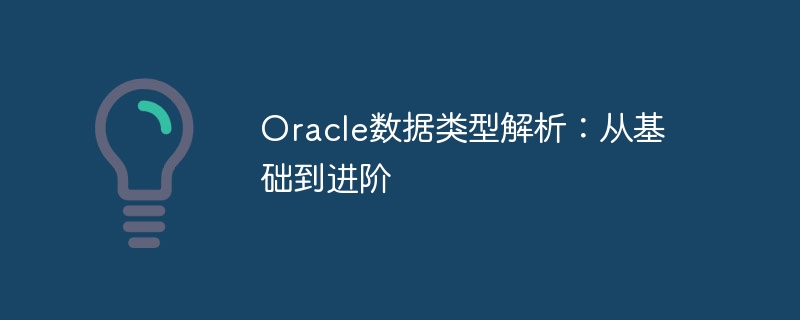

Oracle data type analysis: from basic to advanced
Oracle database is a powerful relational database management system, widely used in enterprise-level application development and Data is being stored. In Oracle database, data type is a very important concept, which defines the format and scope of data storage. This article will systematically introduce the commonly used data types in Oracle database from basic to advanced, including numeric, character, date, etc., and provide specific code examples to help readers better understand.
NUMBER is the most commonly used numeric data type in Oracle database, used to store arbitrary precision numerical value. When creating a table, you can specify the precision and scale of the NUMBER data type. For example, NUMBER(10,2) means that the maximum length is 10 and the value retains two decimal places.
Example:
CREATE TABLE employees (
employee_id NUMBER(5),
salary NUMBER(10,2)
);INTEGER is a data type used to store integers. It takes up less storage space and is suitable for storing large amounts of integer data. scene.
Example:
CREATE TABLE orders (
order_id INTEGER,
quantity INTEGER
);CHAR is used to store fixed-length strings. If the length is insufficient, spaces will be padded at the end. When creating a table, you need to specify the length of the CHAR field.
Example:
CREATE TABLE customers (
customer_id CHAR(10),
customer_name CHAR(50)
);VARCHAR2 is used to store variable-length strings. The length is specified when creating the table. It is suitable for storing variable lengths. Long string scenario.
Example:
CREATE TABLE products (
product_id VARCHAR2(20),
product_name VARCHAR2(100)
);DATE is used to store date and time information, including Year, month, day, hour, minute, second, etc. In Oracle database, dates and times are stored and calculated in a unified format.
Example:
CREATE TABLE transactions (
transaction_id NUMBER,
transaction_date DATE
);CLOB (Character Large Object) is used to store large amounts Text data, which can store up to approximately 4GB of character data.
Example:
CREATE TABLE posts (
post_id NUMBER,
post_content CLOB
);BLOB (Binary Large Object) is used to store large amounts of binary data, such as pictures, audio, videos, etc., can Stores up to approximately 4GB of binary data.
Example:
CREATE TABLE attachments (
attachment_id NUMBER,
attachment_data BLOB
);This article introduces the commonly used data types in Oracle database from basic to advanced, including numerical type, character type, date type, etc., and Specific code examples are provided to help readers better understand. In practical applications, choosing the appropriate data type according to needs is an important part of designing the database table structure. I hope that readers can become more proficient in using the data types of Oracle database through the study of this article.
The above is the detailed content of Oracle data type analysis: from basics to advanced. For more information, please follow other related articles on the PHP Chinese website!




